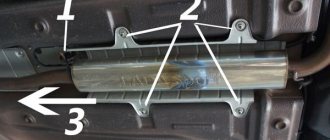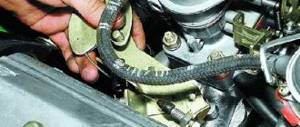The eternal craving for perfection sometimes forces us to improve the seemingly simplest things. But because of this, we get brilliant inventions and discoveries. If a potential Kulibin gets his hands on a car, it means he will definitely modify something to suit himself. Such alterations sometimes have no practical meaning, and sometimes are simply necessary. Everyone decides for themselves, but today we will talk about a car muffler.
A friend asks: maybe I should buy Gazelle Next and become a businessman? I answer him: why not?
Design and purpose of the muffler
There is nothing special about it - just a pipe. This is what people who are far from cars think. This is a fundamentally wrong opinion. The exhaust pipe carries a fairly large load and performs a number of functions that many are not aware of.
Based on the name of the device, it is designed primarily to dampen the noise produced by the combustion process of the working mixture in the combustion chamber. If you look at it, several thousand explosions occur per minute in each cylinder. Despite the fact that this is not a salvo from a howitzer, the running engine is quite noisy - just remember how a moped rumbles without a muffler and multiply this noise by ten. A well-designed muffler can completely absorb this noise.
The design of the muffler is designed in such a way that the acoustic vibrations created by the engine are absorbed by several resonator chambers tuned specifically to the frequency of a particular engine. There can be several cameras, their design can also be very diverse, and in general, the subtleties of the muffler design are a subject for a separate discussion. And today we’ll talk about how to make a muffler for a car with your own hands, what it will give us and what we may lose.
Reasons for making a muffler yourself
To make a muffler for a car with your own hands and spend time, effort and materials, you must have good reasons. And we have them. How convincing and significant the reasons are, everyone decides individually.
- A homemade muffler is designed for a specific car and this eliminates inaccuracies and flaws in installation on seats on the body and engine.
- The materials of purchased mufflers and their anti-corrosion treatment leave much to be desired, so there is no guarantee that the new exhaust pipe will not rust in six months - the service life of the muffler will generally increase.
- It is possible to change the muffler configuration, the number of resonators and its overall length.
- It is possible to independently choose the material for the muffler and the method of processing it. If you use stainless steel pipes, then such a muffler can even survive a car.
- It is possible to customize the sound emitted by a homemade muffler using the entire spectrum of frequencies emitted by the motor.
- You can use a direct-flow muffler design, which slightly affects engine power.
These are not all the advantages of a homemade muffler, only those that lie on the surface, but they are enough to try to please yourself with the new sound of your car.
Main stages of muffler manufacturing
The design of a new muffler for your car depends only on your financial capabilities and ability to work with metal. There are several options:
- You can rework the standard muffler, leaving the main mounting points unchanged;
- Making a muffler from stainless steel - this will make the muffler expensive, but eternal;
- Making a muffler from ordinary thin-walled steel pipes.
If you don’t want to spend money on expensive stainless steel, then ordinary thin-walled pipes are suitable for the new design. The muffler will become a little heavier, but for its sound-absorbing properties this is even better. A very important point - no need to be greedy. Silencers that have already served their purpose even partially are not suitable for making a new exhaust pipe. The fact is that metal has a certain safety margin for heating/cooling cycles and there is no guarantee that a used pipe will not burn out on the second day, even if it looks good.
Muffler resonator
You can make your own muffler resonator from scratch, or you can think about what you can use instead of its body. Many people use old fire extinguishers. This is a very simple option, but the fire extinguisher is heavy and the metal of its body is hardly designed for high temperatures.
The main thing that needs to be taken into account when making a resonator is that the inlet and outlet holes must be offset from each other. You can install partitions in the resonator at your discretion. But more often they do without them at all - they simply drill holes in the welded pipes inside the resonator to swirl the exhaust gases.
The very last resonator can not be filled with anything at all - just leave it in the form of an empty resonating box. It is also important to take into account the weight of the new muffler - if it differs significantly from the standard one, then the elements of its attachment to the bottom will have to be strengthened.
Powder fire extinguisher muffler
Modification of a standard muffler is possible on the basis of a powder fire extinguisher whose service life has expired.
Necessary materials
Additionally, you should prepare:
- welding electrodes 1.5 - 2.5 mm;
- electric welding machine;
- compact grinder with cutting wheels for metal;
- parts of the old muffler;
- two pieces of steel pipe with an internal diameter of two inches.
Stage-by-stage execution of work
The manufacturing process is as follows.
- Prepare a pipe of a suitable size with a diameter of 30 - 52 mm. It is unlikely that you will be able to find thin-walled factory-type pipe, so just use tap pipe.
- Unscrew the cap from the fire extinguisher and get rid of the remaining powder.
- Enlarge the hole until the pipe you prepared fits snugly into it.
- A similar hole must be made on the other side of the cylinder, but it should be slightly shifted towards the wall of the fire extinguisher.
- Use a grinder to create perforations on the end sections located inside the pipes (12 - 15 cm).
- Insert the pipes into the cylinder, calculating the opposite arrangement of the perforated sections opposite each other. The ends should be inserted 60% into the balloon.
- Weld the joints on both sides of the cylinder in a circular direction. Be careful not to burn the metal of the fire extinguisher.
- Remove the fasteners from the old fire extinguisher and weld them onto the resulting homemade structure. Please note that the water pipe is heavier than the factory car pipe, so provide reinforcement for the fastening. On the other hand, the heavier the pipe, the quieter the muffler.
- To reduce noise levels and increase the service life of the structure by two years, insert a flexible corrugation into place after the exhaust manifold. The housing can be filled with glass wool to further reduce noise.
- If you are making a muffler from stainless steel, provide for the possibility of disassembling the structure. It can be partially dismountable, and you will have the opportunity to periodically clean the cavities and make repairs if necessary.
- Be sure to check the tightness and reliability of the welds by plugging one of the pipes and filling it with water upside down. There should not be even a slight leak.
- Drain the water and use a compressor to blow out the product and remove any remaining moisture.
- The design is ready for installation on a car.
We also advise you to carefully read our expert’s article, which describes in detail how the muffler resonator is designed.
You may also be interested in an article by our specialist, in which he talks about how to choose a thermal tape for a muffler.
conclusions
Whatever the purpose of replacing the muffler and the reason for the desire to make it yourself, there is nothing difficult in both technologies if you have basic welding skills.
The muffler is an element of the engine exhaust system. Its presence does not depend on the type of fuel the engine runs on - gasoline, diesel fuel or methane. The muffler dampens sound vibrations, helps attenuate, subside and resonantly reduce sound waves from engine exhaust. Interlocutors will not be able to communicate around a running engine without a muffler. The noise of the engine will drown out their speech. Nevertheless, many car owners dream of remaking the exhaust system and making it forward-flowing. Some people can create it with their own hands.
Operating principle of the resonator
When the engine is running, hot gas enters the exhaust manifold from the cylinders through the valves. The flow is combined in the exhaust pipe and enters the catalyst at high speed. At this stage, the toxic substances contained in the exhaust gases are neutralized.
Next, this flow (and it still does not have time to cool down and slow down) enters the container of a small muffler. The exhaust temperature in this unit still reaches more than 500 degrees Celsius.
In the cavity of the resonator there are several partitions and perforated pipes installed opposite the walls of these bridges. When gas enters the first chamber from the main pipe, the flow hits the jumper and is reflected from it. Next, it encounters a new portion of exhaust gases, and part of the volume enters through a perforated pipe into the next chamber, in which a similar process occurs.
When the exhaust enters the tank, the flow mixes and goes through several stages of reflection from the jumpers, absorption of sound waves occurs and the gas gradually cools. Next, it flows through the exhaust pipe into the main muffler, where an identical process occurs, only with a larger number of stages. It is where the final cooling of the gas and stabilization of the sound wave occurs.
The efficiency of the engine depends on the throughput of this element. The lower the exhaust resistance, the more easily the exhaust gases are removed from the cylinders, making it easier for the crankshaft to rotate, and it does not need to use part of the energy to remove combustion products. This feature is used to create sports exhaust systems. For this reason, such machines are very loud. However, this part cannot be completely removed from the system, since without an exhaust system the car will be less dynamic.
More details about the operation of the exhaust system and the resonator separately are described in this video:
ICE Theory Part 2: Release - from spider to exit
Types of mufflers and their differences
There are 4 types of mufflers based on the method of absorbing acoustic waves:
- reflective;
- restrictive;
- absorption;
- resonator.
The reflective circuit is reverse-flow, the rest are direct-flow.
Reflective
If one muffler is installed in a car, then a reflective version is used. It uses the principle of “breaking” the flow of exhaust gases by creating several partitions, expansion chambers and turns. Exhaust volume is reduced to standard levels. For this reason, the vast majority of factory vehicles are equipped with the reflective type.
most popular for factory vehicle configuration
The disadvantage of this type of muffler is the reduction in engine power due to the resistance of the exhaust system to the flow of exhaust gases.
Resonator
A resonator muffler is installed as the first stage in the exhaust system of powerful engines. It consists of a perforated pipe placed in a housing. The body is divided into two or three sections. The energy of the exhaust gases is weakened due to a stepwise reduction in pressure.
installed as the first stage of exhaust energy suppression
The part reduces the force of sound vibrations and maintains engine power with a free flow of exhaust gases.
Restrictive
In restrictive mufflers, the gas flow passes through a diaphragm or cone narrowing, which leads to a decrease in engine power. The acoustic protection of such devices is low, since the diaphragm does not interfere with the rectilinear movement of the sound wave.
Absorption
The damping function for sound vibrations in the absorption muffler is performed by a finely porous non-flammable material located in the space between the perforated pipe and the housing. The design is similar to the resonator type. This type has little effect on power reduction.
The history of the appearance of the resonator in the exhaust system
With the advent of the first internal combustion engines, the issue of noise reduction and exhaust purification became acute. At first, exhaust systems had a primitive structure, but over time, to increase the efficiency of the system, various auxiliary elements were added to it.
In the first half of the 1900s, a small metal flask with baffles was added to the exhaust system, against which hot gases hit, resulting in reduced exhaust noise. In modern machines, resonators have different shapes and designs.
Replacing a return flow muffler with a direct flow one with your own hands
When manufacturing a direct flow, it is advisable to use the positive properties of several types of structures.
Reasons for replacing a standard muffler with a direct-flow muffler
Car owners change the factory muffler to a direct flow one for several reasons:
- obtaining an increase in engine power;
- subjective improvement of acoustic parameters of the exhaust;
- increasing the aesthetic parameters of the car;
- complete modernization of the exhaust channel;
- The installed muffler has failed.
Tools and materials for work
A direct-flow muffler is often purchased, but for lovers of tools and an insatiable thirst for creativity, we recommend making it yourself. It is preferable to make parts from stainless steel with a thickness of 0.8–2.0 mm. Select ferrous metal blanks with a thickness of 1.0–1.5 mm for the case, the rest 2.0–4.0 mm to avoid premature burnout of parts, and also use standard blanks. For the body, use a suitable size: a fire extinguisher, a thermos, an empty gas or scuba cylinder.
To fill the muffler chamber, non-flammable porous material or a combination of them is used:
- basalt or other mineral wool;
- fine mesh metal mesh;
- metal mesh for the kitchen;
- metal shavings.
- angle grinder (grinder);
- drill or drilling machine;
- welding machine;
- consumables: metal discs for grinders, drills, electrodes, etc.
Reworking an old muffler
- We dismantle the old muffler, disassemble it using a grinder, leaving the body parts and the inlet pipe. While preserving the partitions, we drill holes in them for the passage of exhaust gases. The cameras further reduce exhaust volume.
We cut out everything that is not needed from the old muffler
We perforate the inner pipe in an accessible way. The diameter of the perforated pipe is equal to the diameter of the inlet pipe or more up to 30%.
a small number of small holes will help preserve the rich bass rumble from the engine when exhausting
Keep in mind that mineral wool fibers will be “blown out” of the chamber faster through large holes and grooves.
Stainless steel helps to increase the service life of parts and mechanisms several times
In the future, the diameter of the inner pipe can be reduced by simple manipulations, but increasing it is disproportionately more difficult.
cut the length of the pipe to the required size
We put metal mesh for the kitchen in place of the perforation of the pipe.
cover the internal perforation with fine-porous non-flammable material
Wrap the kitchen mesh tightly with metal mesh in 1-3 layers. We fix the mesh with annealed steel wire with multiple twists or crimp it with several clamps.
We enhance perforation, reducing its permeability to mineral wool
We coordinate and clean the welding points, weld the perforated pipe into its regular place.
We carry out welding in compliance with all safety rules
How to make forward flow quieter
To reduce exhaust volume, devices are used that reduce the flow area of the exhaust pipe of the muffler. Let's look at the damper and flute commonly used on cars.
Damper installation
The damper is installed either before or after the muffler. The volume of the forward exhaust will be clearly reduced only when the damper is completely closed. Technological clearances of 3-5% remain for the passage of exhaust gases - so the engine does not stall. In this regard, engine power is significantly reduced due to blockage of the exhaust system.
the damper is made by hand
A damper is also used to switch from a direct-flow to a return-flow muffler and vice versa, if necessary. In this case, a new muffler is installed parallel to the old one, and the damper is mounted in front of them. This scheme is already used on some brands of cars from the factory.
mechanical adjustment of the damper is carried out on the move by the driver from the cab
You can drive a short distance with the throttle closed, but driving constantly is unacceptable for the engine.
the damper is installed in front of the muffler
Making and installing a flute
The flute (silencer) has more preferable characteristics. It dampens the exhaust pipe clearance much less than a damper. You can buy a flute, knowing the internal diameter of the outlet pipe, or make it yourself. Various silencer designs are shown in the photo.
Flute mounting options
Possible versions of the flute.
- External - for outlet pipe diameters up to 50–60 mm.
method of attaching a flute to a small diameter exhaust pipe
a properly designed flute “helps” you ride more quietly
the sound becomes “more pleasant” to the ears of the traffic inspector
Tools and materials for making a flute
- Bulgarian;
- electric drill;
- welding machine;
- spanners.
It is better to choose blanks from stainless steel with a thickness of 0.8–1.2 mm, which guarantees long service life. Blanks made of “ferrous” metals are acceptable with a thickness of 2.0–2.5 mm or less if we plan to use the flute for short periods. As blanks we use two pieces of pipe and sheet metal for the flange.
Making a flute with your own hands
The order of work performed:
- We adjust all parts to the required dimensions. We measure the dimensions of the flange and larger pipe “on site”.
- We drill holes.
the notch divides the gas exhaust into two streams, which reduces the exhaust volume
To further relieve the exhaust system from excess exhaust gas pressure, holes are drilled in the flange.
additional holes allow for a freer exhaust
the flow of exhaust gases is suppressed due to unloading holes and counterflow
There is no need to paint stainless steel
Videos about the flute
Video: sound of exhaust through forward flow without flute
Video: sound of a flute on the same car
Replacing the resonator
In most cases, resonator repairs are irrational and a waste of the client’s budget. What can we offer? Our experienced craftsmen will find the source of noise and rattling, and will offer you the installation of a flame arrester, stronger or high-temperature resonator. We need to fight not the symptoms, but the cause of the problem. If you do not seek help from a car service in a timely manner, a broken element of the exhaust system may block the exit of exhaust gases, that is, create a traffic jam, and the car will not be able to start the engine.
Noise standards and liability for exceeding them
Responsibility for loud exhaust from a muffler is provided for under Article 8.23 of the Code of Administrative Offenses. The driver is charged for operating a vehicle with excess noise levels in accordance with the Technical Regulations of the Customs Union 018/2011 “On the safety of wheeled vehicles”, paragraph 9.9.
Table: dependence of the maximum permissible sound level on the vehicle category
| Vehicle category | Sound level (in decibels) |
| M1, N1, L | 96 |
| M2, N2 | 98 |
| M3, N3 | 100 |
Category M1, N1 and L are passenger cars with no more than 8 seats, trucks with a permissible maximum weight of no more than 3.5 tons, motorcycles/mopeds/ATVs. Category M2 and N2 are cars with more than 8 seats (except for the driver), but whose maximum weight does not exceed 5 tons, and trucks with a permissible maximum weight from 3.5 to 12 tons, respectively. Category M3 and N3 are full-fledged buses and trucks with a permissible maximum weight of more than 12 tons (trucks, most dump trucks).
According to 12.5.1 of the Code of Administrative Offenses, the driver (or owner) is charged for making changes to the design of the car without the permission of the supervisory authority - the traffic police.
So, the fine for a straight-through muffler can be either a warning plus a fine of 500 rubles, or two fines of 500 rubles each (in practice, two warnings cannot be issued).
The manufacture of a direct-flow muffler and its further improvement is within the power of most car enthusiasts. Despite the restrictions on the operation of such devices in our society, there are more and more people who want to make their own and install a direct-flow muffler on a car. Thanks to detailed instructions with photographs and videos, it will be much easier to make a forward flow.






